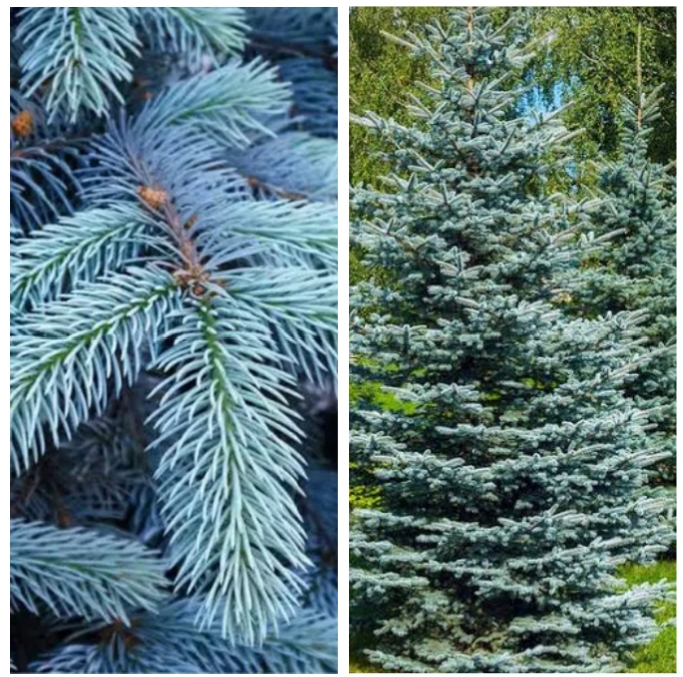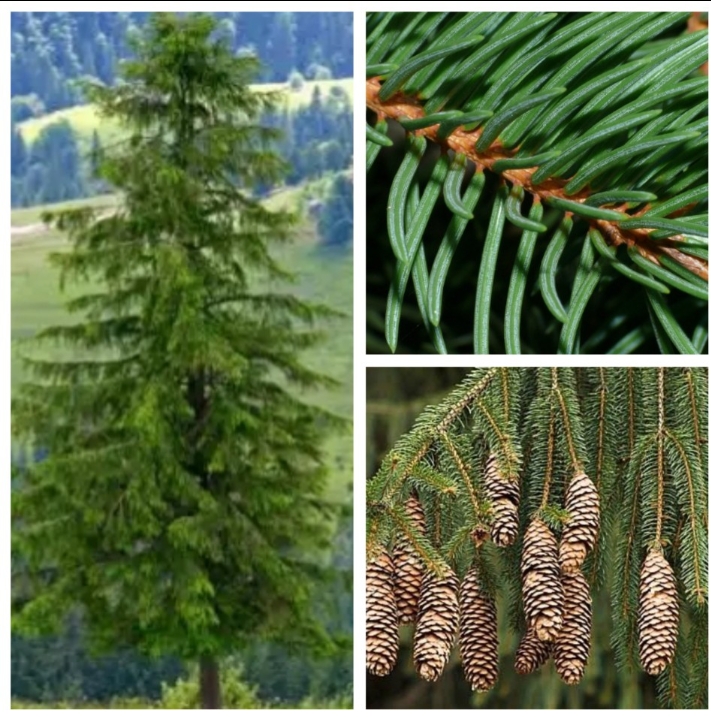Colorado a southwestern U.S state is a diverse landscape of river canyons and Rocky Mountains with almost half its land covered by trees. There are many types of trees that can grow or are found in Colorado, from exotic hardwood to shade trees and flowering trees. Many tree varieties grow in Colorado’s mountainous and higher elevations where the weather is often unpredictable and extreme. This article will try to look at some of the major tree species that define the Colorado state’s landscape.
List of Common Trees In Colorado
- Colorado Blue Spruce
- Norway Spruce
- Douglas Fir
- Narrowleaf Cottonwood
- Quaking Aspen
- Rock Mountain Juniper
- Gambel Oak
- Boxelder Maple
- Catalpa
- Western Hackberry
- Japanese Tree Lilac
- American Elm
- American Sycamore
- Limber Pine
- Peachleaf Willow
Description
Colorado Blue Spruce

The Colorado blue spruce is a coniferous evergreen native to Colorado and it’s the official state tree of Colorado State. It can be found at higher altitudes or around river canyons. It is commonly grown as an ornamental tree in parks and home gardens. It is one of the most commonly used trees for Christmas decorations and backyard landscaping across United States.
Quick Facts
- Scientific Name: Picea pungens
- Other Names: Green spruce or Colorado spruce
- Size: 40-75 feet
- Shape: Columnar or Conical
- Leaves: Waxy gray-green
- Bark: Grayish-brown bark
Norway Spruce

Norway spruce is a fast-growing coniferous evergreen with a wide distribution across the Colorado State. While driving around Colorado, from El Paso, Garfield, Hinsdale, Denver to Broomfield to Las Animas County you won’t miss to observe a Norway spruce tree. It is mainly grown for its wood and together with Colorado blue spruce are popular a choice for Christmas decorations.
Quick Facts
- Norway Spruce: Picea abies
- Other Names: European Spruce
- Size: 30-170 feet
- Shape: Columnar or Conical
- Leaves: Dark green, needle-like with blunt tips
- Shoots: Orange-brown and glabrous
- Seed Cones: Green or Reddish maturing to brown
- Bark: Dark-brown bark
Douglas Fir
Douglas fir is a popular tree for Colorado’s landscape because of its beautiful golden or blue-green color, needle-like leaves and softwood. The species is one of the best timber tree in Colorado as well as a popular ornamental and holiday decoration tree and is also commonly used for reforestation. For some nature lovers in Colorado, this is a great tree for attracting wildlife to the landscape, including hummingbirds, deer mice, chipmunks etc.
- Douglas fir: Pseudotsuga menziesii
- Other Names: Oregon Pine or Columbian pine
- Size: 30-200 feet
- Leaves: Long, flat yellow or blue-green, spirally arranged needles
- Lifespan: 500 years
- Bark: Grey with resin blisters on young trees while corky and fissured in old trees
Narrowleaf Cottonwood
Narrowleaf cottonwood is also common in Colorado. It is a characteristic species of the Rocky Mountains, rivers, streams and creeks. The tree is slime in shape and sometimes grows in tightly packed clusters. You can find this tree species in many home landscapes in Pitkin, Mesa, Park and Lincoln counties.
Quick Facts
- Narrowleaf Cottonwood: Populus angustifolia
- Common Name: Narrowleaf Cottonwood
- Size: 20-60 feet
- Leaves: Narrow, yellow-green, almost resembling those of willow, with scalloped margins.
- Lifespan: 200-400 years
- Bark: Gray and coarse, becoming deeply ridged with age.
Quaking Aspen
Quaking aspen is a medium-size deciduous tree and one among the several iconic trees in the state. They can be found throughout the Rocky Mountain region but are especially abundant in Colorado’s high elevations and home gardens. These trees will commonly be seen growing together with other tree species, thereby creating a unique ecosystem. The tree is also loved by many wild birds including lark bunting, mourning dove, American goldfinch etc.
Quick Facts
- Quaking Aspen: Populus tremuloides
- Other Names: American Aspen, Trembling Aspen, Trembling poplar
- Size: 20-85 feet
- Leaves: Gloss-green leaves becoming golden to yellow in autumn.
- Lifespan: 200-400 years
- Bark: Whitish in color and marked by thick black knots.
Rocky Mountain Juniper
Rocky Mountain Juniper has a long history of use as medicinal plants. They’re found sporadically in very many places throughout the state from Denver, Yuma, Otero, La Plata to Montezuma County. The tree is major planted as an ornamental tree but it is sometimes planted as a windbreak and horticulturally in rocky, poorly irrigated soils. It is a popular collected tree for bonsai not only in Colorado but in the entire United States.
Quick Facts
- Rocky Mountain Juniper: Juniperus scopulorum
- Common Name: Rocky Mountain Juniper
- Size: 15-50 feet
- Leaves: Leaves are needle-like, blue-green and arranged in whorls of three
- Crown: Irregular
- Lifespan: 150 years
- Seed cone: Berry-like, dark blue with a whitish tinge.
- Bark: Greyish-brown and slightly furrowed.
Gambel Oak
Gambel oak is a deciduous small tree or a large shrub that is widespread in the foothills and lower mountains of western Colorado. It can also be found throughout southern Colorado and along Front Range almost to Denver. Large thickets of Gambel oak tend to provide cover and nesting habitat for many forms of wildlife (birds, mammals, amphibians etc.).
Quick Facts
- Gambel Oak: Quercus gambelii
- Other Name: Scrub oak, oak bush
- Size: 15-60 feet
- Leaves: dark green with a paler or velvety underside turning orange and yellow in autumn.
- Lifespan: 300 years
- Acorns: Green to golden brown
- Bark: Brown-reddish-brown.
Boxelder Maple
Boxelder maple is a fast-growing deciduous tree growing in many places in Colorado state as ornamental and shade trees. The leaves of this tree are translucent green and turn yellow or orange in the fall. Boxelder can be found growing along streams, mountain canyons and valleys in lower parts of the Rio Grande and Colorado River basin. Magpies prefer to nest in boxelders and other birds as well as squirrels, chipmunks and mice feed on the seeds.
Quick Facts
- Scientific Name: Acer negundo
- Other Name: Manitoba maple, Ash-leaved maple
- Size: 35-90 feet
- Leaves: Light green and turn yellow in the fall
- Flowers: Yellow-green
- Lifespan: 50-80 years
- Shoots: Green often with a whitish to pink or violet waxy coating when young
- Bark: Pale gray or light brown
Catalpa
Catalpa is a deciduous tree with a shapely oval form. Its strikingly bold and coarse texture adds color and beauty in very many places within Colorado state. You can spot this tree in many wide-open spaces, parkways or around home gardens where it acts as a windbreak or shelterbelt. The tree features large showy flowers between May and June. The biggest problem that most people have with this tree is the mess it makes when the bean pods are shade.
Quick Facts
- Scientific Name: Catalpaspeciosa
- Other Name: Catawba
- Size: 40-60 feet
- Leaves: Pale-green, large and heart-shaped
- Lifespan: 300 years
- Flowers: White to Cream-yellow
- Growth-rate: Medium-fast rate
Western Hackberry
Western hackberry is a medium-sized deciduous tree commonly found throughout the Rocky Mountain region. It has a wavy, rounded crown and has been planted as shade tree extensively in very many places in Colorado. In general, it is easy to identify a hackberry not only from its bark that feature distinctive corky, warty projections but also from its appearance that’s offered marred by bumps on the underside of the leaves.
Quick Facts
- Scientific Name: Celtis occidentalis
- Other Name: Common hackberry, Nettletree, Beaverwood
- Size: 30-50 feet
- Leaves: Bright green and turns yellow in fall.
- Bark: Light brown to silvery gray
- Lifespan: 150 years
- Fruits: Orange-red to dark purple
- Growth-rate: Medium-fast rate
Japanese Tree Lilac
Japanese lilac tree generally grows as a large shrub or a small tree featuring wonderful white scented flowers and while in Colorado you can spot it along boulevards, parks, front-yards and backyard landscapes. In many places like Denver it usually pruned to a single stem or sometimes left to grow as a multi-stemmed shrub. The tree’s bark is red-brown and marked with short horizontal lines, resembling the bark of a cherry tree. Everywhere it grows in Colorado, it is known to attract hummingbirds, butterflies and other insect pollinators to the landscape.
Quick Facts
- Scientific Name: Syringa reticulata
- Common Name: Japanese lilac, Ivory Silk Lilac
- Size: 12-50 feet
- Leaves: Green and elliptic in shape
- Bark: red-brown
- Lifespan: 150 years
- Fruits: Whiteorcreamy–white
American Elm
American elm trees are another tree species that can be spotted in very many municipalities across Colorado. They are probably common because of their fast growth and shade-casting capabilities. They are generally large in size growing in an attractive ‘’Y’’ shape. Unlike many other deciduous trees in Colorado, the foliage of the American elm is not strikingly ornamental. As falls turns to winter, the tree loses all its leaves and enters the period of dormancy.
Quick Facts
- Scientific Name: Ulmus americana
- Common Name: American elm
- Size: 30-80 feet
- Leaves: Oblong, dark green in hue and have a rough texture
- Bark: red-brown
- Lifespan: 200 years
- Flowers: Small green and in drooping clusters
American Sycamore
The American sycamore is a large deciduous tree with spreading limbs at the top forming an open crown. It is common in San Isabel, San Juan and Gunnison National forests in Colorado with long-lived species of over 200 years. Its white bark peels off in patches, giving its trunk and major limbs a colorful mottled appearance. The trunks of large trees are often hollow.
Quick Facts
- Scientific Name: Platanus occidentalis
- Common Name: American elm, American planetree, buttonwood
- Size: 40-120 feet
- Leaves: Green and maple-like with three or five lobes
- Bark: White and peeling off in patches
- Lifespan: 2000 years
Limber Pine
Limber pine is a beautiful evergreen tree with soft, long bluish needles and a pyramid shape. Everywhere it grows in Colorado, it provides a more unique appearance than the typical blue spruce and ponderosa pine. It is a major tree species in Rocky Mountain National Park (RMNP) where it provides food for wildlife and stabilizes steep slopes. It is also found in many home landscapes where it is used for screening or as a specimen tree. Limber pine is a long-lived tree, some Colorado limber pines are more than 1000 years old. There is one in South Park, Colorado that is estimated to be around 1600 years old.
Quick Facts
- Scientific Name: Pinus flexilis
- Other Name: Rocky Mountain White Pine
- Size: 40-90 feet
- Leaves: Bluish-green
- Seed Cones: Immature cones are purple, mature cones are large and brown.
- Wood: Pale lightweight and soft
- Bark: Heavily creased and dark-grey
- Lifespan: 1700 years
Peachleaf Willow
Peachleaf willow is a medium-sized deciduous tree featuring a single trunk and sometimes several shorter trunks. Its leaves curl slightly and hang pendant on their slender flexible stems. In Colorado this tree species can be found in many places including along the Rio Grande, though it is common in Routt, Grand Mesa and Roosevelt National forests where it is common near streams and often accompanying cottonwoods.
Quick Facts
- Scientific Name: Salix amygdaloides
- Common Name: Peachleaf Willow
- Size: 12-70 feet
- Leaves: Yellowish-green with a pale, whitish underside (similar to those of peach or almond)
- Bark: Heavily creased and dark-grey
- Fruit: Reddish-yellow
- Lifespan: 150 years